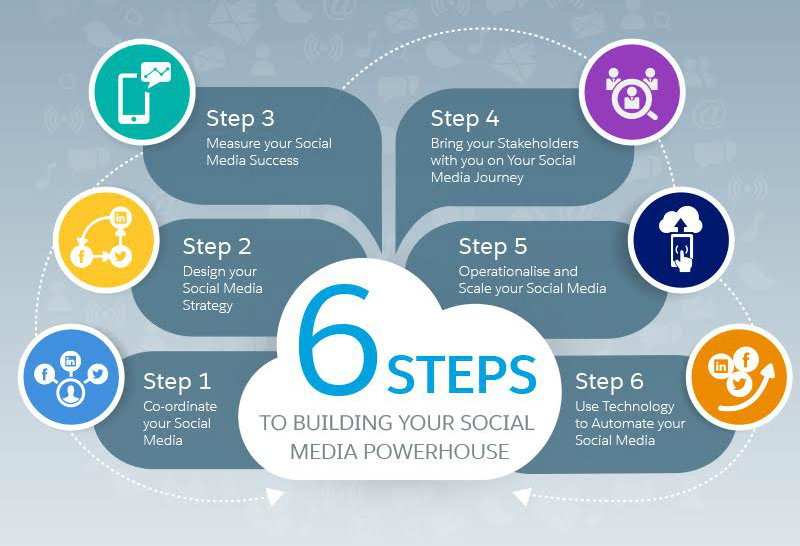
Get your FREE 30-day trial.
Start by selecting a product:
This is Step 5 in the 6 Steps to Building Your Social Media Powerhouse by @eddiecliff
Operationalise and Scale Your Social Media
The 6 Steps play out like this:

How to Operationalise and scale your Social Media - Put it down on Paper!
A critical part of operationalizing your social media strategy is putting it down on paper. Playbook. Manual. Blueprint. Operational Tactical Manual or Standard Operating Procedure. Whatever you call this (I’m going to call this Playbook) you need your strategy and tactics laid down on “paper” (either electronic or hardcopy).
Why do you need a Playbook?
One reason for the need for a Playbook is clear. Even in small to medium sized businesses, let alone large multinationals, turnover is expected, and you don't want your social media activity to be a victim of personnel attrition. Your playbook is helpful both for the purposes of retaining corporate knowledge - all that hard work detailed in the last four blogs; but also for easy and consistent on-boarding of new team members as your powerhouse grows.
Most importantly you want clear and agreed upon processes for engagement in all defined scenarios. Because you have already discussed these processes with the departments involved, the playbook serves a point of signoff and agreement between the social media team (the hub) and each department (the spokes). Having everyone agree to and sign-off on the playbook is an important part of bringing your stakeholders with you, which we wrote about in the last post.
Establishing “Swimlanes”
The process is not only an important part of stakeholder management, but helps mitigate risk and avoid internal conflict. Clear directives about what to do in common day-to-day interactions helps co-operation between departments and enables quick decision making and empowerment on the frontline. Everyone knows who is responsible for what, and no one is stepping on or getting their toes stepped on.
Additionally, having a playbook makes the design of approvals, workflows, and permission frameworks much easier. You have a defined structure. These form what are known as "swim lanes" to keep everyone on track with their specific responsibilities. Then when the time comes to adopt the technology needed to scale your powerhouse, setup and configuration becomes a much easier process (which we’ll write about in the next post).
The playbook is also a place where you can capture best practice over time. Which means you MUST maintain and optimize your playbook. The playbook isn't something you spend hours compiling only for it to sit on a shelf collecting dust. This must be a living, breathing document always evolving with platform, strategy, and internal organizational changes.
Symantec’s “Actionable Internet Mentions”
An inspiring example of how the Playbook can deliver huge value back to the business is the work Symantec did in creating their Social Media Playbook. The process included the development of unique Intellectual Property in its “Actionable Internet Mention” (AIM) classification model. AIM was a classification process applied to each and every mention to determine the who, what, when, and where of how each social interaction would be managed. Based on the AIM classification, each interaction is then automatically routed to the relevant department for handling, creating an audit trail along the way.
If you watch this (four minute) presentation by Symantec’s Director of Digital Strategy, Tristan Bishop; what you’ll notice is throughout the process he “reached out” to one team or another to check with them that the protocol they had designed for each mention worked for that team. For instance, having a workflow for capturing product feedback and routing it through to the product development teams was a welcomed initiative for harvesting product enhancement ideas.
The hard work put into the playbook development process enables an organisation like Symantec to fundamentally understand all of the business implications of each possible scenario and build workflow and governance to handle each. Symantec’s playbook included 7 different departments and when successfully implemented the new workflow resulted in a 75 per cent reduction in “Case Response Time” because of its efficiency. The hard work pays off.
For more on this important stage in building your Own Social Media Powerhouse, download this helpful Guide to creating your Social Media Playbook:
Stay tuned for the next and final post - Step 6: Use Technology To Automate Your Social Media
See Steps 1, 2, 3 and 4:
Step 1: Co-ordinate Your Social Media
Step 2: Design Your Social Media Strategy
Step 3: Measure Your Social Media Success
Step 4: Bring Your Stakeholders With You